A Weekly CoinWeek Column by Greg Reynolds
News and Analysis regarding scarce coins, coin markets, and the coin collecting community #129 …..
Barber Quarters are a very popular series of U.S. coins. Although I frequently write about gem quality (65 and higher grade) Barber Quarters that sell in major auctions, it is important to keep in mind that most collectors of Barber Quarters are unable or unwilling to pay the substantial sums that gem quality coins command. Well-circulated Barber Quarters do not cost a fortune, and thousands of people collect them.
The three keys are relatively expensive, dramatically more so than most classic (pre-1934), better date, U.S. silver coins. The three keys are the 1896-S, the 1901-S and the 1913-S. Low grade, key date, Barber Quarters are ‘in the news’ as the Goldbergs just auctioned several on Sept. 3rd, in Los Angeles, a few days before the recent Long Beach Expo.
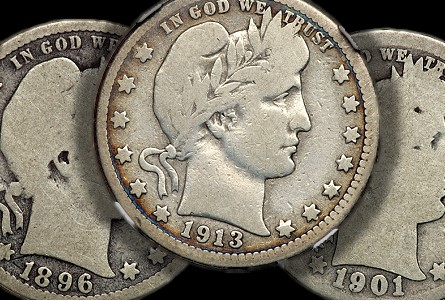 When deciding whether to collect Barber Quarters, or to formulate a collecting strategy for obtaining them, it is important to consider the market prices of the keys. The purpose here is to discuss collecting circulated Barber Quarters, with the idea that it may make sense for some collectors to include well worn keys in a set that otherwise consists of Very Fine to AU, or even uncirculated (‘Mint State’) Barber Quarters.
When deciding whether to collect Barber Quarters, or to formulate a collecting strategy for obtaining them, it is important to consider the market prices of the keys. The purpose here is to discuss collecting circulated Barber Quarters, with the idea that it may make sense for some collectors to include well worn keys in a set that otherwise consists of Very Fine to AU, or even uncirculated (‘Mint State’) Barber Quarters.
Also, people who cannot afford choice (MS-63 or -64) or gem quality (65 and higher grade) Barber Quarters should consider circulated coins. These are fun to collect. Alternatively. people who collect uncirculated (‘MS-60 or higher grade’) Barber Quarters can include well-circulated representatives of the keys, in their respective sets, for the purpose of saving money. The notion of buying ‘low grade’ keys to complete a set of otherwise much higher grader coins can be an important aspect of a collecting strategy.
One concept that tends to distinguish coin collecting from some other cultural pursuits is that coin collectors often like to complete sets, while collectors of paintings or antique furniture do not often think in terms of ‘completion’ or ‘sets.’ Indeed, in the culture of coin collecting, there is substantial agreement as to how particular sets are defined. While some details may be subjective, the overall definitions and requirements of sets of U.S. coins are largely objective.
Of course, I am not assuming that all coin collectors wish to complete sets and I am not asserting that an excellent coin collection needs to include complete sets. On the contrary, there are other, widely accepted collecting plans. Besides, an incomplete set may often by superior to a complete set.
I will discuss alternatives to building sets in the future, as the present purpose relates to means of completing sets. For several series, not just for Barber Quarters, key dates in low grades are often illogically shunned and are relatively affordable. So, I hope that even collectors who are not interested in Barber Quarters will take seriously my discussion here, as my points relate to several other series of coins and to sets in general.
Before discussing prices for low grade keys, I introduce Barber Quarters. Very experienced coin collectors may wish to skip the next two sections and read about recent auction results for the keys to the series of Barber Quarters.
I. What are Barber Quarters?
Like Barber Dimes, Barber Quarters were minted from 1892 to 1916. Barber Half Dollars were last struck in 1915. Although Charles Barber designed five cent nickel coins, which date from 1883 to 1913, these are called ‘Liberty Nickels’ rather than Barber Nickels. The artistic designs of Liberty Nickels, however, are much different from the designs of Charles Barber’s regular issue, silver coins.
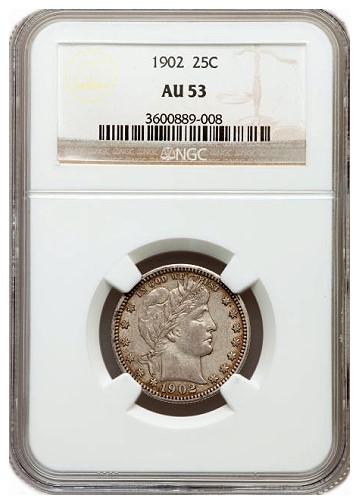 Charles Barber also designed medals and several commemoratives. Plus, he modified Augustus Saint Gaudens’ designs for Double Eagles ($20 gold coins) and Eagles ($10 coins).
Charles Barber also designed medals and several commemoratives. Plus, he modified Augustus Saint Gaudens’ designs for Double Eagles ($20 gold coins) and Eagles ($10 coins).
Barber Dimes, Barber Quarters and Barber Half dollars all have very similar obverse (front) designs. The reverse (tail) designs of the quarters and half dollars are also very similar.
The heraldic eagle on the back of the quarters and halves would not have fit comfortably on the reverse (back) of a dime. Furthermore, a long term U.S. Mint policy was for an eagle to appear on quarters, halves and silver dollars, though not on other silver denominations. After 1837, there are no representations of eagles on silver half dimes or on any dimes. Three Cent Silver coins were minted from 1851 to 1873 and these do not feature an eagle. The short lived denomination of silver Twenty Cent pieces, however, dates from 1875 to 1878 and these do feature an eagle on the reverse (back).
Barber Quarters are 90% silver, or were so when struck. Barber coins tend to wear well. Indeed, even heavily worn Barber coins exhibit an understandable and pleasing outline of the design. When I was a kid, I collected all three denominations in Fair-02 to Fine-12 grades. These were then less costly. Many kids now, though, can afford Barber Dimes. I remember being happy with Barber Dimes that grade AG-03 or even Fair-02, many of which may now be acquired for less than $3 each.
Barber coins were struck at four U.S. Mints. Those made at the headquarters Mint in Philadelphia do not have mintmarks. Coins struck in New Orleans each have an ‘O’ mintmark and those struck in Denver have a ‘D.’ The San Francisco Mint employs an ‘S’ mintmark.
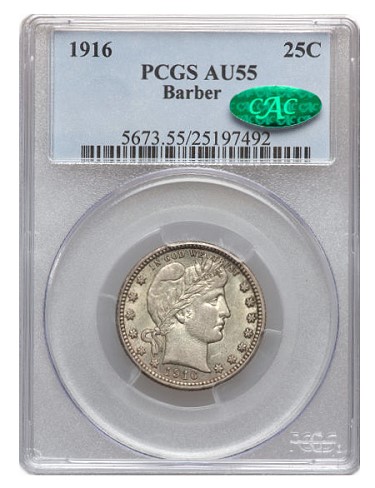 Now, the most common dates in the Barber Quarter series, in Good-04 grade, are available for slightly over melt (silver bullion) value. Collectors can find them for around $8 each at coin shows and coin shops. One leading dealer offers Good-04 grade Barber Quarters via mail order for $10.50 each.
Now, the most common dates in the Barber Quarter series, in Good-04 grade, are available for slightly over melt (silver bullion) value. Collectors can find them for around $8 each at coin shows and coin shops. One leading dealer offers Good-04 grade Barber Quarters via mail order for $10.50 each.
The Philadelphia Mint dates of the 20th century are very common. The 1915-D and the 1916-D are very common as well. When I was a kid, I easily found 1914-D quarters and 1914-D dimes, in Good to Fine grades.
The 1908-O is probably the most common New Orleans Mint Barber Quarter. My impression is that a Good-04 grade 1908-O retails for less than $10, maybe even around $8.50. An 1908-O that grades below Good-04 might be found for melt value, which varies in accordance with the daily market value of silver as a metal. As for Denver Mint coins, the 1906-D, the 1907-D and the 1909-D probably each cost around the same price, more or less, as the 1908-O.
A 1902-O, a 1906-O or a 1907-O could not cost much more, if any more, than a 1908-O, in most cases. A 1909-O, however, is a significantly better date and may cost $30 in Good-04 grade. The New Orleans Mint closed in 1909. A 1901-O is a still better date and would probably retail for around $55 in Good-04 grade.
Among 19th century New Orleans dates, the 1892-O, the 1893-O and the 1899-O are all modestly priced at around $12 to $17 in Good-04 grade. The 1898-O is, I suggest, a sound value, if found for less than $18.50 in Good-04 grade.
Philadelphia Mint Barber Quarters from the 19th century cost around $11.50 to $14 each in Good-04 grade. San Francisco Mint Barber Quarters tend to be more expensive.
Common San Francisco Mint Barber Quarters tend to retail for $12 to $15 in Good-04 grade, including the 1900-S, 1902-S, 1907-S, 1909-S, 1911-S, and 1912-S. Most of the others cost at least $20, often much more. A 1914-S in Good grade would probably retail for at least $110, maybe as much as $150.
The most common 19th century San Francisco Barber Quarter is the 1894-S, which is probably available for $12 or $13, at retail. Collectors can often find coins for less than retail prices, especially from part-time dealers at coin shows or at coin shops that happen to have many circulated Barber Quarters in inventory. It is important to be careful, though, as many coins offered at seemingly bargain prices actually have serious problems, which may not be evident to beginners. It is a good idea to learn a little about Barber Quarters before buying better dates.
Beyond most better dates are the semi-keys. These include the following, with estimated values for Good-04 grade coins in parentheses: the 1892-S ($38), the 1893-S ($27), the 1896-O ($48), especially the 1897-S ($110), and the 1901-O ($52). I already mentioned the 1914-S.
In grades above Good-04, circulated common dates are not very expensive. A Barber Quarter in Very Good-08 grade could certainly be found, without too much difficulty, for less than $15. A Barber Quarter in Fine-12 grade costs just a couple dollars more.
A VF-20 grade, common date Barber Quarter probably retails for around $30. A not certified EF-40 grade common date may cost around $60. I would recommend, though, paying $70 to $90 for one that is PCGS or NGC graded.
An AU-50 Barber Quarter, with natural toning, is likely to retail for more than $115. It might make more sense to buy AU-50 grade Barber Quarters at auction. Yes, the successful bidder generally pays for postage and handling. Even so, auction prices for these will tend to be in the upper part of the applicable wholesale price range or the lower part of the retail range.
In an Internet-only auction on Sept. 9th, Heritage sold an NGC graded AU-53 1902 for $84. Price guides tend to value this coin in AU-53 grade for between $125 and $150. As I have not seen this specific coin, I will not comment on it. It do not have a reason to believe that it is not a nice coin. In this same sale, an NGC graded AU-53 1914 sold for $111.63.
On Sept. 8th, in the recently concluded Long Beach auction by Heritage, a 1916 Barber Quarter that is PCGS graded AU-55, and has a CAC sticker, sold for $117.50, probably a weak price. To form an opinion as to whether this is an exceptional value, I would really need to see the coin.
In the same auction, from the same “Norva Collection,” a PCGS graded AU-55 1915 sold for $146.88. The “Norva Collection” 1910, also PCGS graded AU-55, realized $141.
A retail price for a PCGS or NGC certified MS-60 or MS-61 Barber Quarter is likely to be more than $200. I would avoid these. Coins that grade 60 tend to have very annoying imperfections, and there are often irritating issues relating to Barber coins that grade 61.
A MS-62 grade coin certainly could be found for a price in the $250 to $300 range. Indeed, in the Heritage Long Beach auction, an NGC graded MS-62 1902 sold for $217.38. In a ‘retail setting,’ where a prospective collector-buyer would have the opportunity to take his time inspecting the coin before committing to a purchase, this same coin would probably sell for more than $250. At the Heritage pre-ANA sale in August, a PCGS graded MS-62 1907 Barber Quarter sold for $258.20.
Of course, better dates will tend to cost more, often much more, than common dates of the same respective grades. I refer to Barber Quarters in Good-04 grade and to prices for common dates in several grades to provide ideas of relative values. After all, it is not practical and would be boring to discuss the value of every date in every grade.
Besides, each coin is different and there is no simple formula for determining market values. Regarding market prices for and quality of specific coins, there are legitimate differences of opinion among experts.
II. PCGS, NGC and not gradable coins
Because opinions about coins will vary, and because some sellers deliberately or carelessly misrepresent coins, it is important for collectors to have some idea as to how graders at the PCGS and the NGC evaluate coins. Collectors should not expect to become experts themselves.
Though it is not financially efficient to send EF-40 grade, common date Barber Quarters to the PCGS or the NGC, many collectors have done so, partly out of curiosity. Furthermore, it is frequently educational to find out if particular coins, with substantial imperfections, are determined to be gradable by experts at the PCGS or the NGC. It is often best for a collector to risk relatively small amounts of money while he or she is learning to distinguish the gradable from the ungradable. Besides, not all full-time dealers are competent graders.
There are several reasons as to why a collector may wish to find out how his or her ‘not certified’ coins will be rated at the PCGS or the NGC, even including some coins that are worth less than $100 each. When collectors buy classic U.S. coins that are valued at more than $250 each, they should only buy coins that are already PCGS or NGC graded. Of course, experts at the PCGS and the NGC are imperfect. No one can ‘bat one thousand’ so to speak. There are many variables relating to coin grading and submission activities. I have seen plenty of PCGS or NGC certified coins, with numerical grades, which leading grading experts would regard as overgraded or as coins that should not have been graded at all.
Even so, buying PCGS or NGC certified coins involves much less risk than the purchase of similar coins that are not PCGS or NGC certified. It is easy to sell PCGS or NGC certified coins and usually fair minimum prices can be easily established for them. Besides, most not certified, classic U.S. coins, which are priced above $250 each, have, in the past, been submitted to the PCGS or the NGC, where they failed to receive numerical grades. If practical, when buying Barber Quarters priced at above even $175 each, insist upon coins that have received numerical grades from the PCGS or the NGC.
As for not gradable coins, these should sell for substantially less than corresponding gradable coins. If a Barber Quarter is not gradable and has the ‘details’ of an EF-40 grade coin, it would not make sense to pay a price that corresponds a gradable VF-30 quarter of the same date (and Mint location). The non-gradable coin should sell for much less than an EF-40 level or a even a VF-20 level price. The value of a not gradable coin depends, in part, upon the seriousness and extant of its problems. Collectors should discuss non-gradable coins with experts, and should also seek to learn about them over time. Ungradable coins, even when fairly represented, may sometime turn out to be terrible values.
It is best to start by spending sums that the individual collector regards as ‘small,’ from his own perspective. An amount that is small for one person may be very large to another. It is important to figure collecting budgets and likely risks, given the respective individual collector’s particular situation.
III. 1896-S
All three keys in the Barber Quarter series were produced at the San Francisco Mint. The 1896-S is the only one of the three that dates from the 19th century.
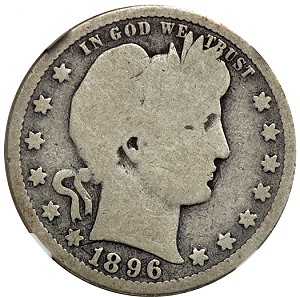 There were four ‘Good’ grade 1896-S quarters in the recent Goldbergs auction, plus another that is not gradable. One is NGC graded Good-04 and is CAC approved. It sold for $644, perhaps a better value for the buyer than for the consignor. It was from the “Dr. Charles Ruby Collection.”
There were four ‘Good’ grade 1896-S quarters in the recent Goldbergs auction, plus another that is not gradable. One is NGC graded Good-04 and is CAC approved. It sold for $644, perhaps a better value for the buyer than for the consignor. It was from the “Dr. Charles Ruby Collection.”
Curiously, the Goldbergs auctioned three that are each NGC graded Good-06. One has a CAC sticker. It brought $834. The other two sold for $719. These are fair market prices. Interestingly, in March 2012, Stack’s-Bowers auctioned a PCGS graded Good-06 1896-S for this exact same price, $719.
The other 1896-S that the Goldbergs sold on Labor Day has been determined to be not gradable by experts at the NGC, with the details of a Fine grade coin. As I have not seen it, I will not comment on it, other than to point out that the price realized of $1852 is very strong. One possibility is that a leading bidder planned to tamper with this coin for the purpose of re-submitting it to the PCGS or the NGC, with the hope that it will receive a numerical grade. Even that objective would be a little puzzling, given the $1852 result, a PCGS or NGC graded Fine-12 1896-S probably would not sell at auction for over $2000, in the current market environment.
IV. 1901-S
The 1901-S is the scarcest Barber Quarter. The Goldbergs offered five on Labor Day, four of which sold. The one that did not sell is definitely not gradable and was damaged in a peculiar manner.
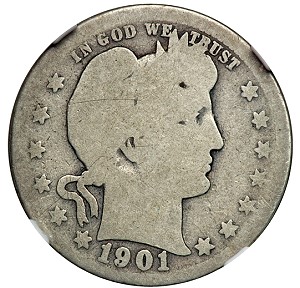 Two of these 1901-S Quarters are NGC graded AG-03. Curiously, the one that does not have a CAC sticker realized much more than the one that has a CAC sticker, $3393 to $2243. Both are from the “Dr. Charles Ruby Collection,” which is famous in the history of coin collecting. Most of Dr. Ruby’s coins were sold in past eras.
Two of these 1901-S Quarters are NGC graded AG-03. Curiously, the one that does not have a CAC sticker realized much more than the one that has a CAC sticker, $3393 to $2243. Both are from the “Dr. Charles Ruby Collection,” which is famous in the history of coin collecting. Most of Dr. Ruby’s coins were sold in past eras.
According to the EAC club, Ruby died in 1996. His silver dollars and copper coins were auctioned by the Goldbergs in the mid 1970s. The Ruby Collection coins in this very recent Goldbergs auction were probably from his estate and/or were consigned by one of his heirs.
As for these two Ruby Collection 1901-S Quarters, while the CAC approved one may possibly have superior surfaces, the NGC graded AG-03 1901-S that is not CAC approved has rims that are much more intact. A leading bidder may have figured that it will upgrade to Good-04, and then could be wholesaled for a price above $3393.
The $2243 price for the CAC approved AG-03 1901-S is not weak. Estimated values in widely read, retail guides are too high for 1901-S quarters in this grade. This result is in the upper echelon of the wholesale range. The retail range, for this coin, is from $2350 to $2700, or so.
A Good-06 1901-S costs substantially more than an AG-03 grade 1901-S. The NGC graded Gd-06 coin in this auction, also from the “Dr. Charles Ruby Collection,” brought $4370, a modest market price.
One of the reasons why circulated, key date Barber Quarters are bringing prices that are lower than the values indicated in some price guides is that the market levels for these have fallen over the last few years, especially over the last two years. Not all price guides have been adjusted accordingly. One leading retailer, in a September 2012 price list, is offering a PCGS graded Good-06 1901-S for “$9000,” which may have been a standard retail price in the near past and is an above-market price now.
The NGC graded VG-08 1901-S in this Goldbergs auction sold for almost twice as much as the NGC graded Gd-06 coin, $8683. It, too, is listed as being from the “Dr. Charles Ruby Collection.”
To further consider my point that well worn 1901-S quarters are relatively affordable, please read my article on the highest certified 1901-S quarter. It sold for $327,750 at a Spectrum-B&M auction on March 4, 2010.
V. 1913-S
The 1913-S is a key that is not often talked about. It is scarce in all grades. There were three well worn 1913-S quarters in this Goldbergs auction, two of which are reported to be from the “Dr. Charles Ruby Collection,” including the one that is NGC graded Fair-02. It went for $489. It would be very hard to find a gradable 1913-S for a lower price. Plus, the online images give the impression that this is a decent coin that is more than attractive for its grade.
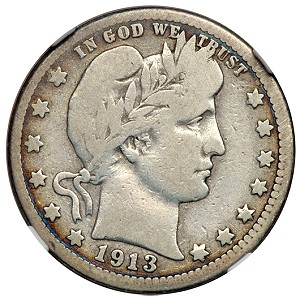 The NGC graded AG-03 1913-S that sold on Labor Day is not from Dr. Ruby’s collection. It sold for $805. In the Heritage Long Beach auction that was held two years ago, in Sept. 2010, a PCGS graded AG-03 1913-S brought this exact same price, $805. In March 2012, Stack’s-Bowers auctioned an NGC graded AG-03 1901-S for $748. More recently, on Sept. 9, 2012, Heritage sold a PCGS graded AG-03 1913-S for $822.50.
The NGC graded AG-03 1913-S that sold on Labor Day is not from Dr. Ruby’s collection. It sold for $805. In the Heritage Long Beach auction that was held two years ago, in Sept. 2010, a PCGS graded AG-03 1913-S brought this exact same price, $805. In March 2012, Stack’s-Bowers auctioned an NGC graded AG-03 1901-S for $748. More recently, on Sept. 9, 2012, Heritage sold a PCGS graded AG-03 1913-S for $822.50.
It is difficult to compare prices without actually seeing the coins in actuality. Even so, it seems that $805 is likely to be a modest, market price for this 1913-S, despite the fact that a leading mail order dealer is asking “$1250” for a PCGS graded AG-03 1913-S. He may not have adjusted his prices to reflect a decline in market levels for key date Barbers over the last few years, especially over the last twelve months.
My discussion here is not an auction review. To analyze auction results, there is really a need to see the coins and/or to discuss them with grading experts who have carefully examined them. After all, two coins of the same design type, denomination, date, U.S. Mint location, grade, and certification by the same service, may be very different. There are variables that are not reflected in auction catalogues or online images.
Here, I am emphasizing the fact that well worn representatives of the keys to this series each sell for a fraction of the price of high grade representatives. The auction record for a 1913-S is $172,500, for a PCGS graded MS-68 coin in a Heritage auction in 2005. An AU-55 grade 1913-S has a retail value in the neighborhood of $10,000.
The late Dr. Ruby’s NGC graded VG-08 1913-S realized $1955. Now, in 2012, this result is a slightly strong price. It certainly would not have been considered a strong price in 2010 or in 2007. Nonetheless, it is probably less than one-fifth the retail price of an AU-55 grade 1913-S, and is a fraction of the price of a MS-64 grade 1913-S. Sometimes, it is a good idea to acquire well worn coins to complete sets. Most collectors regard key date Barber Quarters, in high grades, as expensive.
©2012 Greg Reynolds





Great Article. I picked up a 96 S and 13 S Barber Quarter recently.